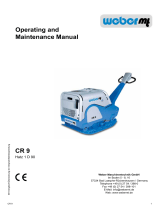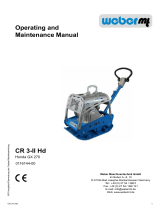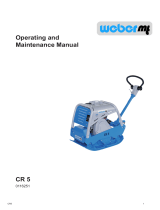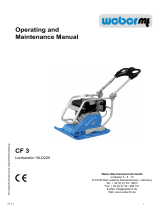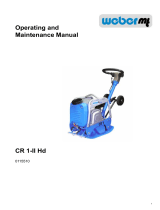Page is loading ...

CF 3-II H 1
CF 3-II H
CF 3/60 H
0100321, 0100323
Operating and
Maintenance Manual

2 CF 3-II H

CF 3-II H 3
Table of contents
Introduction 4
Safety guidelines 5
Graphic presentation 8
Device description 9
Technical data 10
Activities prior to starting work 12
Starting 14
Compacting 15
Shutting down 15
Maintenance overview 16
Maintenance work 17
Operating uids and ll levels 20
Troubleshooting 20
Storage 21
Contact addresses 22

4 CF 3-II H
Introduction
This operating and maintenance manual is designed to facilitate familiarization with your soil
compactor, and to enable you to maintain the compactor and use it for its intended purpose.
When complying with the instructions in the operating and maintenance manual you help
avoid hazards, reduce repair and downtime costs, and increase the reliability and service life
of your soil compactor.
This operating and maintenance manual must always be available at the implementation site
of the soil compactor.
If necessary, you can obtain additional information from your authorized WEBER MT dealer,
or you can obtain information from one of the contact addresses on the last page.
Information concerning the assembled Hatz diesel engine, as well as a spare parts list for
the engine is provided at www.hatz-diesel.com
The valid conformity declaration is enclosed with every machine delivery.

CF 3-II H 5
Safety guidelines
General
All safety instructions must be read and complied with, as non-compliance will result in
– danger to life and limb of the user,
– impairments to the machine or other property.
In addition to the operating manual, the accident-prevention regulations in the country where the
appliance is used must be complied with.
Intended use
The soil compactor should only be used if it is in a technically faultless condition, as intended,
in a safety-conscious and hazard-conscious manner, in compliance with the instructions in
the operating manual. Malfunctions that impair safety must be eliminated without delay.
The CF 3-II H soil compactor is designed exclusively for compacting
– sand,
– gravel,
– crushed rock,
– low-cohesive mixed material,
– concrete paving stone.
Any other use of the soil compactor is considered to be improper use for which the owner shall
be exclusively responsible. All liability is rejected if damage occurs due to non-compliance with
this provision. This risk is borne solely by the user.
Easily foreseeable misuse
Any use for which the machine is not intended.
Operation
Soil compactors are only permitted to be operated by suitable persons of or above the age of 18.
Personnel must be instructed in how to guide the compactor by the owner or by the owner’s assigned
personnel.
The machine operator must comply with trac regulations. If instructions that aect safety are given
by third parties, then the operator must be authorized to reject these instructions.
Unauthorized persons are not allowed in the area of the soil compactor during the compacting
process.
Protective equipment
This machine is capable of exceeding the permissible sound level of 80 dB(A). The owner might also
face additional dangers when using the machine. Precautionary action must, therefore, be taken.
Hearing protection
Hard hat
Safety shoes
Protective gloves
Protective equipment includes:

6 CF 3-II H
Operation
Prior to starting work the owner of the compactor must be familiar with the work environment.
The work environment includes obstacles in the work and trac area, the bearing capacity of
the ground, as well as the necessary safeguarding of the construction site in the area adjacent to
public trac; and it includes compliance with trac regulations.
The soil compactor should only be operated when the protective xtures are mounted. The protective
xtures must all be in functional condition.
At least once per shift the compactor must be checked for apparent defects. If there are apparent
defects then operation of the compactor must be stopped immediately, and the responsible person
must be informed. Prior to restarting, compactor malfunctions that have occurred must be corrected.
Always maintain adequate clearance to the edges of pits and embankments.
Do not drive at ninety degrees to slopes to prevent the compactor from tipping over.
After work has been concluded secure the compactor in accordance with statutory regulations,
particularly in the area of public trac surfaces.
Maintenance and repair work
Only use original Weber MT spare parts to ensure reliable and safe operation for maintenance
or repair work.
Hydraulic hose lines must be checked at regular intervals in accordance with standard engineering
practice, or they must be replaced at appropriate intervals, even if no signs of safety-relevant defects
are present.
Adjusting tasks, maintenance tasks, and inspection tasks must be carried out on schedule as
specied in this operating and maintenance manual. These activities should only be executed by
instructed personnel.
For repair, service, or inspection work the engine of the compactor must be safeguarded against
unintentional starting.
All pressurized lines, particularly hydraulic lines and lines of the injection system of the drive motor
must be depressurized before performing maintenance or repair tasks.
For maintenance and repair tasks the compactor must be parked on a level and stable substrate
and must be secured from rolling o or tipping over.
Heavy components and assemblies must be secured to and lifted by hoisting machines that can
bear their weight when they are replaced. Ensure that no hazard is caused by raising components
or assemblies.
Do not position yourself or work under suspended loads.
If lubricating oils and fuel come into contact with skin, they can cause skin cancer. Upon contact
with the skin, clean aected skin with suitable cleaning agent without delay.
Operation under dicult conditions
Never inhale the exhaust gas. It contains carbon monoxide, a colorless and odorless gas that
is extremely hazardous, which, if inhaled even briey, can cause unconsciousness and death.
Therefore, never operate the engines in enclosed areas or in areas that are poorly ventilated
(tunnels, caves, covered pits, etc.).
Exercise particular caution when operating the engine in the vicinity of people and livestock.

CF 3-II H 7
Inspection
Compactors must be inspected in accordance with the corresponding implementation conditions
and operating conditions, as needed; however an inspection to ensure operationally safe status
must be performed by an expert at least once a year. The results of the inspection must be recorded
in writing and must be stored at least until the next inspection.
Cleaning work
Prior to cleaning the compactor with a high-pressure cleaner, protect all accessible energized
switches, cable connections, etc. against water penetration by masking them o.
Cleaning tasks should only be executed in areas that are suitable and have been approved for
this purpose (oil separator amongst others).
Disposal
All operating uids and auxiliary materials must be disposed of in an environmentally compatible
manner in accordance with country-specic regulations.
Important information for operating and maintenance personnel is marked by pictograms.
Warning against irritants or materials hazardous to health
Warning against a hazardous place
Warning against a suspended load
Wear ear protection
General regulation
Environmental protection
Hard hat
Safety shoes
Protective gloves

8 CF 3-II H
4
64
5
7
3
2
1
Graphic presentation
Overall view CF 3-II H
1 Engine
2 Guide bar
3 Engine bracket
4 Base plate
5 Gas lever
6 Exciter
7 Hearing protection (sticker)
8 Undercarriage (accessory), no image
9 Water tank (accessory), no image
10 Vulkollan plate (accessory), no image

CF 3-II H 9
Device description
The CF 3-II H soil compactor is used for road-building and landscaping compaction tasks.
Drive
The compactor is propelled by an air-cooled Hatz diesel engine.
Force is transferred to the exciter mechanically via a V-belt.
Operation
Start the Hatz diesel engine with the attached reversing starter. After starting, vibration is switched
on via the centrifugal clutch attached to the engine.
Use the gas lever to vary the engine speed between idle and full throttle.
The guide bar is used to steer the soil compactor.

10 CF 3-II H
Technical data
CF 3-II H
Weight
Operating weight CECE in kg (basic device) 108
Dimensions
Overall length (in mm) 1100
Overall width 500
Height with folded guide bar (in mm) 650
Base plate length (base in mm) 400
Pressure surface (in mm) 400 x 500
Drive
Engine manufacturer Hatz
Type 1 B 20
Performance at operating speed in accordance
with ISO 3046-1 (kW) 3.10
Combustion process 4-stroke diesel
Operating speed (1/min) 3000
Operating speed (ground-dependent in m/min) 26
Incline capacity (soil-dependent, in %) 35
Area capacity (in m²/h) 780
Vibration
System Single shaft vibrator
Drive concept Mechanical
Frequency (in Hz) 95
Centrifugal force (in kN) 20
CF 3-II H
Noise emissions in accordance with 2000/14/EC
99
108
Sound pressure level LPA ascertained in accordance
with EN 500, in dB (A)
Sound power level LWA ascertained in accordance
with EN ISO 3744 and EN 500, in dB (A)
Vibration values
3.9
Root-mean-square acceleration value
for hand-arm vibration ascertained in accordance
with EN 500 in m/s²
In accordance with directive 2006/42/EC,
complying with the vibration values is
the owner’s responsibility.

CF 3-II H 11
2
1
3 4
56
1 Description 2 TYPE
........................................................... ...........................................................
3 Serial number 4 Year of construction
........................................................... ...........................................................
5 Mass 6 Rated power kW
........................................................... ...........................................................

12 CF 3-II H
1
4
2
3
5
Activities prior to starting work
Transport
Fit the crane hook into the lifting ring (1) and lift the machine
onto the desired means of transport.
When transporting the soil compactor on a vehicle,
secure it with suitable restraints.
Only use lifting machines with a minimum bearing
capacity of 200 kg.
Do not step under suspended loads.
Mounting the undercarriage
Use the screws (3) to fasten the undercarriage (2) to
the engine console.
Arrest the guide bar (4) with the spring bolt (5).
Pivot the hand truck under the base plate.
The manual guidance rod must be locked during
transport.

CF 3-II H 13
2
1
3
Check the engine oil level
Unscrew and pull the oil dipstick (1) out of the
crankcase.
The correct oil level is between the min. and max. marks.
Insert the oil dip stick in the oil ller neck, but do not
screw it in.
Stop operating the engine immediately when the
oil level reaches the min. mark and top up oil until it
reaches the max. mark. Risk of engine damage if the
oil level drops below the minimum oil level in unfavor-
able operating conditions.
min max
Check the fuel level
Open and remove the gas cap (2), check the level,
if necessary top o to the lower edge of the ller neck
with clean fuel in accordance with the specication.
For work at the fuel system, have a suitable re-
extinguishing agent at the ready.
Fire, naked light, and smoking is forbidden!
Installing the protective mat
Hook in the protective mat at the rear.
Fasten with holder, screws, spring-lock washers
and nuts (3) on the base plate front.
Ensure that the protective mat rests under the
base plate.

14 CF 3-II H
1
2
3
2
3
1
Mounting the water sprinkling system
Lift the water tank (1) into the frame (2).
Completely empty the water tank if there might be a frost.
Attach the water spray pipe (3) to the base plate.
Starting
Bring the gas lever (1) into full-throttle position.
Slowly tighten the handle (2) of the reversing starter (3)
until resistance is noticeable.
Allow the handle (2) to glide back into the initial position,
and then forcefully and completely pull it through with
both hands.
If ambient temperatures are below minus
5 degrees Celsius, comply with the instructions
in the operating manual provided by the engine
manufacturer!

CF 3-II H 15
2
1
3
4
Compacting
Bring the gas lever (1) into full-throttle position.
Control drive speed and direction of travel with the handle (2).
Only guide the machine in the handle area of the guide bar.
Shutting down
Bring the gas lever (3) into idling position.
Press the switch-o button (4).
The engine can only be switched o via the switch-o
button!
During breaks – even if they are short – the machine
must be shut down.
Parked devices that represent an obstacle must be
safeguarded against through conspicuous measures.

16 CF 3-II H
The regulations of the engine manufacturer must be complied with in addition to the above main-
tenance overview!
Tasks must be executed using proper tools, and the safety instructions of this operating and
maintenance manual must be complied with for all tasks.
All maintenance work: select collection vessels large enough to prevent oil from spilling onto the
ground. Dispose of waste oil in an environmentally friendly manner (regulation on waste oils).
Dispose of oils, greases, cloths soaked in oil, and replaced parts with oil on them in an environ-
mentally friendly manner.
If lubricating oils and fuel come into contact with skin, they can cause skin cancer. Upon contact
with the skin, clean aected skin with suitable cleaning agent without delay.
If accessible during maintenance, check the condition and stability of all screws.
Maintenance overview
Maintenance interval Maintenance point Maintenance activity
after the rst
25 operating hours
Engine – Change the engine oil
– Check valve play;
adjust if necessary
– Re-tighten all accessible
threaded connections
every 8 operating hours /
daily
Air lter – Clean air lter insert,
check for damage,
replace if necessary
every 150 operating
hours / every 6 months
Engine – Change the engine oil
– Change the fuel lter
– Change the oil lter
every 150 operating
hours / every year
Gearshift
Exciter
– Change oil
– Change oil
every 250 operating
hours
Engine – Check valve play;
adjust if necessary

CF 3-II H 17
1
2
3
2
1
4
Maintenance work
Change the engine oil
Remove the oil dip stick (1).
Screw the oil drain pipe (2) onto the drain valve and drain
the oil.
Only drain engine oil when at operating temperature.
After emptying completely, unscrew the oil drain pipe
from the drain valve and ll with oil in accordance with
the specication.
Risk of scalding due to hot oil.
When working in the area of the engine compartment
there is a danger of being burnt!
If lubricating oils and fuel come into contact with skin, they
can cause skin cancer. Upon contact with the skin, clean
aected skin with suitable cleaning agent without delay.
Dispose of oils, greases, cloths soaked in oil, and
replaced parts with oil on them in an environmentally
friendly manner.
Clean the engine oil lter
Drain engine oil.
Loosen the screw (1) approximately 5 revolutions.
Pull the oil lter (2) out of the motor compartment.
Blow out the oil lter (2) from inside to outside
with compressed air.
Prior to tightening the screws ensure that the tension
springs rest on the oil lter with both ends (4).
Lightly oil the sealing rings (3) on both sides of the oil lter.
Check sealing rings (3) for damage and rm seat, replace
the oil lter if there is damage.
Press the oil lter into the crankcase as far as it will go.

18 CF 3-II H
6
4
3
1
2
5
Changing the oil in the exciter
Remove the oil drain plug / ller plug (6) and drain oil.
Fill with oil as specied in the ll quantity table.
Screw in the oil drain / ller screw.
Clean / change air lter cartridge
Unscrew the air lter cover (3).
Remove the air lter insert (4) from the air lter enclosure
by unscrewing the nut (5).
Clean the air lter insert in accordance with the guidelines
provided by the engine manufacturer or replace it if it is
extremely dirty.
Change the fuel lter
Pull the fuel line (2) o the fuel lter (1) on both sides.
Replace the lter with a new lter element.
Dispose of oils, greases, cloths soaked in oil, and replaced
parts with oil on them in an environmentally friendly manner.
If lubricating oils and fuel come into contact with skin, they
can cause skin cancer. Upon contact with the skin, clean
aected skin with suitable cleaning agent without delay.
Dispose of oils, greases, cloths soaked in oil, and
replaced parts with oil on them in an environmentally
friendly manner.
Select collection vessels large enough to prevent oil from
spilling onto the ground. Dispose of waste oil in an envi-
ronmentally friendly manner (regulation on waste oils).
Wipe up / o oil slick and oil residue and dispose of
fuel-soaked cleaning cloths in an environmentally re-
sponsible manner.

CF 3-II H 19
2
1
Checking the V-belt
Remove the V-belt guard (1).
Check the V-belt (2) for cracks, damaged anks, and wear.
If there is excessive wear – replace the V-belt as specied
in the repair manual.

20 CF 3-II H
Operating uids and ll levels
Assembly Operating material Quantity
Summer Winter CF 3-II H
Quality
Engine
Engine oil SAE 10 W 40
(– 10 ~ + 50 °C)
API – CD CE-CF-CG
or SHPD
or CCMC – D4 – D5 – PD2
0.9 l
Fuel tank Diesel
Diesel in accordance
with DIN 51601-DK
or BS2869-A1/A2
or STM D975-1D/2D
3.0 l
Vibrator Fully-synthetic transmission uid
API GL-5/GL-4
First lling Fuchs Titan SINTOPOID
LS SAE 75W-90
0.2 l
Troubleshooting
Fault Possible cause Remedy
Soil compactor
does not start
Operating error
Lack of fuel
Fuel lter fouled
Air lter fouled
Execute start process
as prescribed
Check the fuel level
Change the fuel lter
Clean / change air lter
cartridge
No vibration /
no forward motion
or insucient
forward motion
Vibrator V-belt defective Change vibrator V-belt
Soil compactor
does not switch
Wrong hydraulic oil level
in the guide bar
Check oil level
Correct oil level
/


